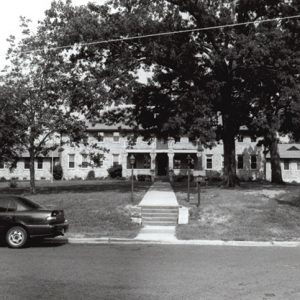calsfoundation@cals.org
Interstate Orphanage
aka: Ouachita Children’s Center
aka: Interstate Orphans’ Home
aka: Hot Springs Children's Home
aka: Hot Springs Orphans' Home
The Interstate Orphans’ Home—today known as the Ouachita Children’s Center—is located at 339 Charteroak Street in Hot Springs (Garland County). It was the first institution in Hot Springs to care for orphans and other destitute children. The Craftsman-style brick structure was listed on the National Register of Historic Places as the Interstate Orphanage in 1982 and is attributed to noted Arkansas architect Charles L. Thompson. Throughout its history, the nonprofit facility has been called the Interstate Orphans’ Home, Hot Springs Orphans’ Home, Hot Springs Children’s Home, and Ouachita Children’s Center.
In 1910, a home located at 322 Morrison in Hot Springs was organized to care for the area’s needy children. By 1918, a large, white wood-frame house was acquired for an orphanage, but it burned in 1926. While a new structure was being built, the children were housed in a building at the corner of Virgil and Maurice streets.
In 1928, the Hot Springs Kiwanis Club kicked off a $25,000 fund drive, raising $27,000 in two days. Local workmen volunteered weeks of free labor. The facility was built on a 7.5-acre tract of land at what was then 339 Combs Street and considered to be “in the county.” Its cornerstone reads: “Interstate Orphans Home—1928—in memory of Otto Neubert.” The land had been donated by Otto Neubert, an area philanthropist.
Neubert also left the bulk of his estate, about $117,000 (a considerable amount of money at the time) to the children’s home. He had been inspired by Catherine Charity Birnbaum (1854–1938), who was the president of the home’s board of directors. She was known as “Mother” Birnbaum, and for many years, she made daily solicitations among local businesses for money to maintain the children’s home. She was a familiar figure at the home—sewing, buying gifts for the children, and bringing them apples. In 1930, her work also inspired the legacy of Otto Griesbach and his wife, who established a trust fund for the home. Birnbaum served the home as an advocate and member of the board of directors until her death.
In its early years, the orphanage was a working farm. The spacious brick building had rooms that were described as bright and airy. There were dormitories at each end of the wings, plus a library and recreation room. Early operating expenses included a budget for utilities, clothing, a commissary, and a garden, as well as electrical, plumbing, and general repairs, along with wages for a cook, nurse, superintendent, and matron. In its first year of operation, these amounted to a little over $8,000.
While the need for an orphanage faded somewhat as the state shifted its efforts toward placing more children in foster homes and juvenile training schools, community groups such as the Lions Club recognized the need for a place to care for abused, neglected, and troubled young people. Through their efforts, the facility became the Ouachita Children’s Center (OCC) in 1977 to provide emergency shelter for homeless, runaway, and troubled youths. The building and land were deeded to OCC by the Hot Springs Children’s Home Board when its corporation was dissolved. In 2004, the facility was dedicated as the Joe Poe Building, in honor of a longtime member of the board.
OCC serves youth referred by the juvenile courts of Garland and Clark counties, as well as the Division of Youth Services of the Arkansas Department of Human Services (ADHS), local schools, community agencies, families, and young people themselves. Additionally, it cares for abused or neglected children referred by ADHS’s Division of Children and Family Services.
OCC provides both residential and non-residential services to young people aged 6–17, including emergency shelter and respite care; children may come from anywhere in the state of Arkansas. OCC strives to promote positive life experiences for young people and provide them with the tools to succeed as adults. The facility can accept up to twenty-two children, with an average stay of forty-five days. In 2014, OCC assisted more than 500 children through its various programs.
For additional information:
Anthony, Isabel Burton. “Ouachita Children’s Center.” In Garland County, Arkansas: Our History and Heritage. Hot Springs, AR: Garland County Historical Society, 2009.
Creason, Katherine B. “The Hot Springs Children’s Home and One Devoted Worker.” The Record 6 (1965): 78–84.
“Interstate Orphanage.” National Register of Historic Places nomination form. On file at Arkansas Historic Preservation Program, Little Rock, Arkansas. Online at http://www.arkansaspreservation.com/National-Register-Listings/PDF/GA0480.nr.pdf (accessed November 23, 2020).
Ouachita Children’s Center. http://www.occnet.org (accessed November 23, 2020).
Nancy Hendricks
Garland County Historical Society

 Interstate Orphanage
Interstate Orphanage 



Comments
No comments on this entry yet.